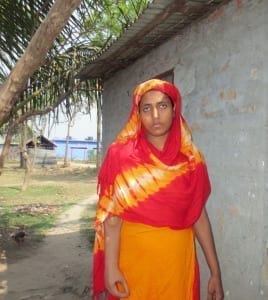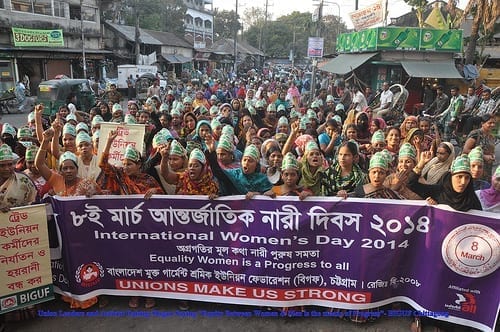Apr 18, 2014

Moriom Begun survived the Rana Plaza collapse but lives in constant pain. Credit: Solidarity Center
When the multistory Rana Plaza building collapsed on April 24, 2014, in Bangladesh, Moriom Begum was trapped for two days in the room where she worked as a sewing operator. Hunched in the dark, unable to move beneath a sewing stool and suffering from serious injuries, Moriom was surrounded by the lifeless bodies of her co-workers. As the long hours dragged by, Moriom thought, “I will never see the world again.”
Moriom, who had worked for more than three years at New Wave Style, one of five factories in the building, lost her right hand in the disaster and suffers from continuous pain in her wrist. She recently was fitted with an artificial hand, but she says “the hand is very heavy. “This hand seems like an extra burden for me.”
Like many of the garment workers in Rana Plaza the day of the collapse, Moriom and her colleagues didn’t want to enter into the factory. The day before, engineers had identified cracks so serious they said the building should be closed immediately. But many factory managers threatened workers, saying they would be fired if they did not show up for work the next day.
More than 1,110 workers were killed and thousands more injured when the building pancaked. A government inquiry concluded that substandard construction materials and the vibration of heavy machinery in the five garment factories were prime triggers of the building’s collapse.
Moriom, 30, came to Dhaka, the Bangladesh capital, five years ago to provide her for her children. A single mother, she has returned to her village where she now looks after her parents and two children.
For the next few years, Moriom will receive enough monthly compensation from the Bangladesh government to support her family. To collect it, she must travel to Dhaka every month. But the money will eventually run out. She doubts she can ever work in a garment factory again and has set her hopes on launching a small food store.
“When people have their own hands, it is a big thing,” said Moriom. “The owners can get back money that they lost, but the workers won’t get back what they have lost.”
The government and the employers should understand the value of other people’s life, she said. If they value life, they will ensure that no more garment workers are injured or killed.
If Moriom had a chance, she would like to tell factory owners that they “should pay the workers according to the load of work you put on them.”
Despite her difficulty sleeping, her ongoing pain and her new caretaking burdens, Moriom remains positive because she expects her children will have a better life than she experienced.
“I may face lots of pain. But I hope my children will be educated and not face any problems in the future.”

Apr 18, 2014
Garment workers continue to be fired and harassed at the Taratex BD Ltd. factory in Gazipur, Bangladesh, according to the Bangladesh Independent Garment Workers Union Federation (BIGUF). More than 100 workers have been fired since they filed for union registration at the factory on February 4.
On Sunday, BIGUF says factory managers detained the new union president and general secretary and pressured them to immediately resign from their positions in the factory by signing previously prepared documents. They signed the documents after they were reportedly threatened, and were then removed from the factory.
The two leaders were elected after the factory terminated the union’s 12 executive committee members in the lead up to the union being registered on April 4. Six union members told BIGUF they have been forced to leave their homes for fear of their personal safety.
BIGUF is working with the factory union to file an unfair labor practice in addition to the one it filed in February 24. The federation says it remains “deeply concerned about the ongoing pattern of anti-union retaliation and mass terminations at Taratex.”
BIGUF is calling for immediate reinstatement and back pay for all workers who have been fired. Further, BIGUF says, authorities must send a clear message that terminations and other forms of anti-union intimidation are unacceptable, will not be tolerated and will be fully prosecuted in accordance with the law.
Apr 17, 2014

Despite rising exports, Haitian garment workers are paid so little they can barely afford food. Credit: Lauren Stewart
Despite a 45 percent increase in apparel exports since the 2010 earthquake in Haiti, the women and men who sew T-shirts and jeans primarily destined for the U.S. market barely earn enough to pay for their lunch and transportation to work, a new Solidarity Center survey finds.
The average cost of living for an export apparel worker in Port-au-Prince is 26,150 Haitian gourdes (about $607) per month. Yet workers are paid only between 200 gourdes (about $4.64) and 300 gourdes for an eight-hour day (about $6.96). After insurance and social security deductions, most export apparel workers must spend more than half of their salaries on transportation to and from the factory and a modest lunch, leaving little to sustain a family or keep a roof over their heads.
“Workers interviewed in this study had to forgo basic necessities given the disparity between their earned wages and the cost of living,” according to the report. “When asked what they would purchase if they had sufficient income, workers responded with: more food to feed their families, land to build a home, (and) a car or moped to drive their children to school.”
The Solidarity Center survey finds that a real living wage must be approximately 1,000 gourdes (about $23) per day to enable workers to meet basic needs. Haitian unions are demanding a minimum wage increase to at least 500 gourdes (about $11.60) per day and assert that anything lower equates to starvation wages. Despite the export industry’s growth, Haitian law mandates a reduced minimum wage for the sector, which is the lowest in the Western Hemisphere.
Housing (rental) costs spiked immediately after the earthquake, but prices have since fallen by nearly 28 percent. Yet workers still live in substandard housing and pay up to four times more than what they did prior to the disaster. Some families are unable to afford their children’s transportation to school, so many students must walk, sometimes long distances and along busy roads.
“The High Cost of Low Wages in Haiti” analyzed such expense categories as housing, energy, nutrition, clothing, health care, education and transportation to classify the costs of an export apparel worker. The report also includes charts breaking down each category of expense. It follows a similar informal study the Solidarity Center conducted after the earthquake and used the same locally appropriate basket of goods to calculate the cost of living for a three-member household, comprised of one adult wage earner and two minor dependents (ages 8–14).
The report concludes: “Workers need access to decent jobs that pay a living wage and allow them to lead a dignified life. So long as jobs perpetuate worker exploitation and serve only as a means to fend off starvation, poverty will continue to grip the country and hinder the reconstruction process.”
Read the full report.
Apr 11, 2014

Fiona Magaya, ZCTU Gender Department coordinator, is helping lead outreach among women workers. Photo: John Hosinski
Zimbabwe women workers are key to ensuring the implementation of workplace rights established by the country’s new constitution, says Fiona Magaya, coordinator of the Zimbabwe Congress of Trade Unions (ZCTU) Gender Department.
The constitution, ratified in 2013, also expands the rights of women, but to make those rights a reality, “We have to train women to know these rights and to build on these rights in the workplace,” she says.
As part of that effort, ZCTU and its Gender Department are rolling out awareness trainings at the regional level. Nationally, the federation is promoting policy changes that would improve labor laws covering family leave for women and men, maternity leave and sexual harassment. The federation also is backing a proposed Domestic Violence Act that addresses gender-based violence.
Zimbabwe workers are struggling in an environment of large-scale job losses, hollow government budgets and regular violations of worker rights. Since January 1, roughly 70 companies have not reopened—affecting some 9,000 workers. Many workers lucky enough to have a job often work for months without pay, unable to walk away because of the lack of alternatives and fearful that they may not be able to return to work.
As the number of jobs in the formal economy declines, workers in the informal economy increase. The vast majority of people laboring in the informal economy are women, and ZCTU is developing strategies to mobilize and empower them. A series of studies and audits that ZCTU has commissioned since 2010 shows the extent to which women workers face economic marginalization and hurdles to full participation in unions. ZCTU notes, for example, that women hold only 21 percent of union leadership positions; most union affiliates do not have gender policies; and the overwhelming majority of union organizers and negotiators are men. Women workers recognize a disconnect between their priorities and those of union leadership.
ZCTU has developed and is promoting an internal gender policy and has created a social media strategy to open communication among women workers and union leaders. The federation actively participates in the ITUC-sponsored Decisions for Life Campaignaimed at empowering young women to make informed decisions about work, career and family, while also improving their ability to demand decent jobs and equal opportunities at work.ZCTU is seeking to expand Decisions for Life to include young men.
ZCTU also adopted a provision at its 2011 congress requiring equal representation for men and women in decision-making and in union training programs by 2016. While the goal is ambitious, Magaya is optimistic that the federation is making progress and sees an increase in women’s participation and parity.
“These programs don’t require many resources because women are saying ‘count us in,’” she said.
“We need to speak to their grievances and their needs.”
Apr 9, 2014

James Kofi Annan describes child labor in Ghana. Credit: Sharon Farmer/sfphotoworks
Reducing and eliminating child labor requires a focus on decent work for adults, said Solidarity Center Executive Director Shawna Bader-Blau, speaking yesterday on Capitol Hill. Such an approach, she said, must build the capacity of vulnerable workers to negotiate the terms of their employment and to advocate for local and national policies that address the economic welfare of entire communities.
Bader-Blau joined a panel of experts in a congressional briefing, “Combating Exploitative Child Labor,” sponsored by the Alliance to End Slavery & Trafficking (ATEST), a coalition spearheaded by the nonprofit Humanity United, and the Child Labor Coalition—both of which include the Solidarity Center. (Watch a video of the full event.)
More than 168 million children around the world are engaged in child labor. David Abramowitz, vice president for Policy and Government Relations at Humanity United and a participant in the discussion, defined child labor as work that is mentally, physically, socially or morally dangerous and which interferes with children’s education. In the most extreme forms, children are enslaved, separated from their families or exposed to serious hazards and illnesses.
Another participant in the event, James Kofi Annan, was enslaved as a child laborer in Ghana, where he was forced to work as a fisherman on Lake Volta in the coastal town of Winneba.
“I know what it means to go through torture,” said Annan, who went on to become an advocate to end child labor. Annan founded Challenging Heights, where 800 former child laborers now attend school in the Winneba community. He also operates a shelter for 50 children rescued from the worst forms of child labor.
Annan introduced Sen. Tom Harkin, a long-time champion of ending child labor, who pushed for the International Labor Organization (ILO) standard on eliminating the worst forms of child labor (Convention 182) and sponsored the Harkin-Engel Protocol, which addresses child labor in the cocoa industry. Harkin also spearheaded the creation of the Labor Department’s annual report on the List of Goods Made with Forced Labor or Child Labor.
“It’s not just enough to get these kids out of the worst forms of child labor. We have to build schools, we have to hire teachers,” Harkin said. Although he is retiring from the Senate this year, Harkin, who has traveled to Ghana several times to investigate child labor, said he would continue to be involved in the issue.
Getting children out of work and into school is the outcome of a path-breaking collective bargaining agreement workers reached at the Firestone plantation in Liberia, said Bader-Blau. After forming a union, the workers, with assistance from the Solidarity Center, negotiated a reduction in the high daily production quota of latex. Parents had been forced to bring their children to work to meet the high quotas. The new union, FAWUL, negotiated lower daily quotas so adult workers could meet them, and achieved free accessible education for the workers’ children.





